How the Brits Stole High-Tech
American architects invented the style, but Brits like Norman Foster made it sing.
-
courtesy of Nigel Young/Foster + Partners.
Sainsbury Centre for Visual Arts (Norman Foster, architect), 1974-78
My new book, The Biography of a Building, tells the story of how an unusual client and a talented architect produced an outstanding work of architecture. The client was Sir Robert Sainsbury, scion of the British supermarket-owning family; the architect was Norman Foster, at the time a relatively unknown 37-year-old; and the building was the Sainsbury Centre for Visual Arts at the University of East Anglia, considered one of Foster’s great works, and this year nominated for a heritage listing. The long aluminum shed, which houses a museum, a teaching department, and a student cafeteria, is an example of a style that has come to be known as high-tech. The term came into use in the 1960s, and refers to industries such as aerospace and computer manufacturing, but in an architectural context it describes an approach that incorporates advanced industrial materials and techniques, and favors forms influenced by engineering rather than by the plastic arts.
-
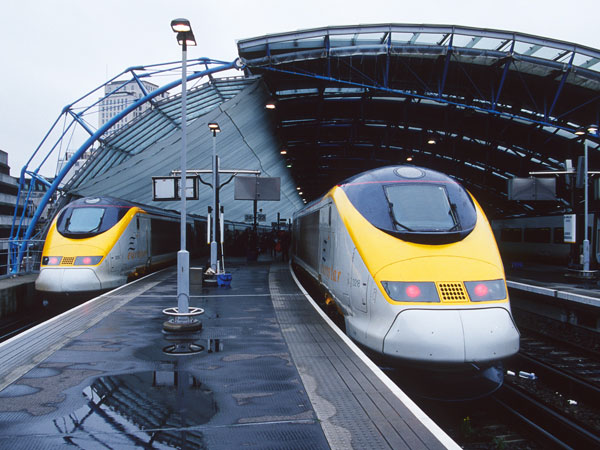 Herbert Ortner, via Wikimedia Commons.
Herbert Ortner, via Wikimedia Commons.Waterloo Eurostar terminal, London (Nicholas Grimshaw, architect), 1993
High-tech’s most prominent practitioners are Norman Foster; Richard Rogers; Michael Hopkins, who has been a partner of Foster; Nicholas Grimshaw, the designer of the Eurostar terminal at Waterloo (left); and Renzo Piano, who in 1977 with Rogers built the first high-profile high-tech building, the Pompidou Center. Not that these architects see themselves as belonging to a school. Like all creative people, they dislike being pigeon-holed, and in any case, like many architectural labels, “high-tech” does not bear close scrutiny. Nevertheless Foster, Rogers, and company have a lot in common: They favor lightweight steel structures, are partial to industrially produced components, design generalized spaces that can be used flexibly, and emphasize a building’s performance rather than merely its appearance. And with the exception of Piano, they are all Brits.
-
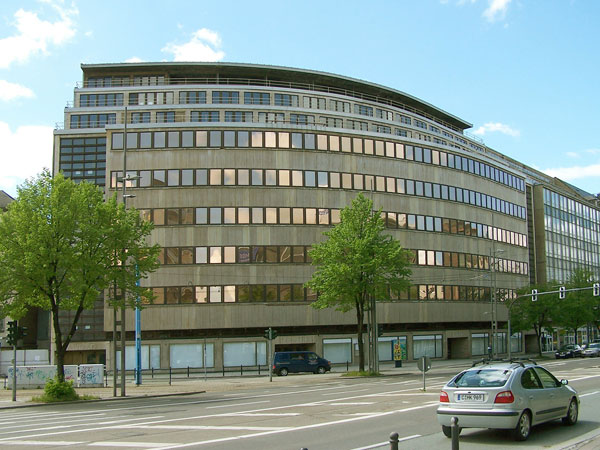 Sandstein, a.k.a. TheBernFiles, via Wikimedia Commons.
Sandstein, a.k.a. TheBernFiles, via Wikimedia Commons.Schocken Department Store (Erich Mendelsohn, architect), 1930
The high-tech architecture that emerged in Britain in the 1970s belongs to a European tradition that dates back to early modernists such as Bruno Taut, whose pavilion at the 1914 Werkbund exhibition in Cologne used glass in an adventurous way, and Erich Mendelsohn, who built some extraordinarily glass buildings in Germany in the 1920s. The tradition continued in the 1930s, with the Dutch architect Frits Peutz, who designed the Modehuis Schunck, a department store in Heerlen that was locally nicknamed the Glass Palace, thanks to its delicate all-glass façade, and the Parisian Pierre Chareau, who was responsible for the remarkable Maison de Verre. The postwar link to the high-tech architects is the French engineer, Jean Prouvé, who designed building components, furniture, and a series of lightweight, prefabricated steel buildings.
-
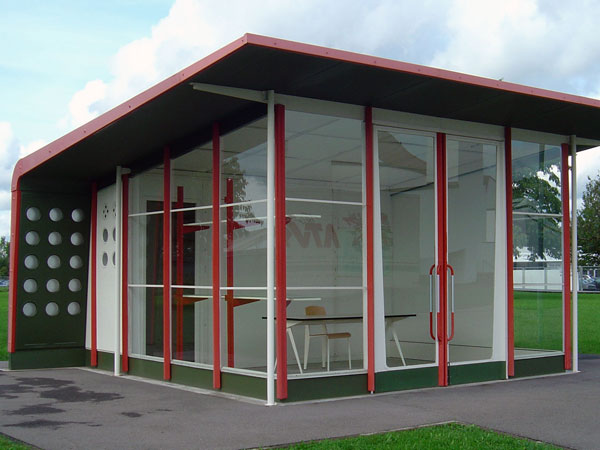 Reinhard Höll, via Wikimedia Commons.
Reinhard Höll, via Wikimedia Commons.Prefab Service Station (Jean Prouvé, architect), originally designed c. 1953
Architects such as Taut, Mendelsohn, Peutz, and Chareau exploited the lightweight possibilities of steel and glass, and used industrial materials to a much greater extent than their Bauhaus-influenced contemporaries. However, thanks to the proselytizing writings of historians such as Sigfried Giedion and Nikolaus Pevsner, and Henry-Russell Hitchcock and Philip Johnson’s famous 1932 “Modern Architecture—International Exhibition” at New York’s Museum of Modern Art, the work of Taut and the others was marginalized, and the prominence accorded to the designs of Le Corbusier, Mies van der Rohe, and Walter Gropius ensured the dominance of Bauhaus-style modernism. The lightweight work of architects such as Prouvé (left), was largely ignored.
-
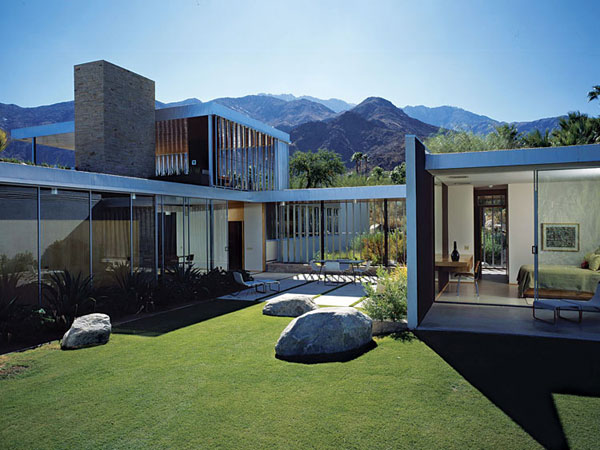 courtesy of Christie's.
courtesy of Christie's.Kaufman House (Richard Neutra, architect), 1946
The American chapter in the history of what might be called “lightweight modernism” unfolded in Southern California. It began in the 1920s with the arrival of Richard Neutra in Los Angeles. A Viennese who had worked for Mendelsohn, Neutra married the International Style with lightweight American construction technology, and produced a series of hybrid houses, consisting of extremely slender steel frames infilled with glass and prefabricated panels. His two masterpieces, the airy Lovell house in Los Angeles and the Kauffman house in Palm Springs, are replete with what Reyner Banham called “skinny details,” a feature that became one of the hallmarks of the Southern California style.
-
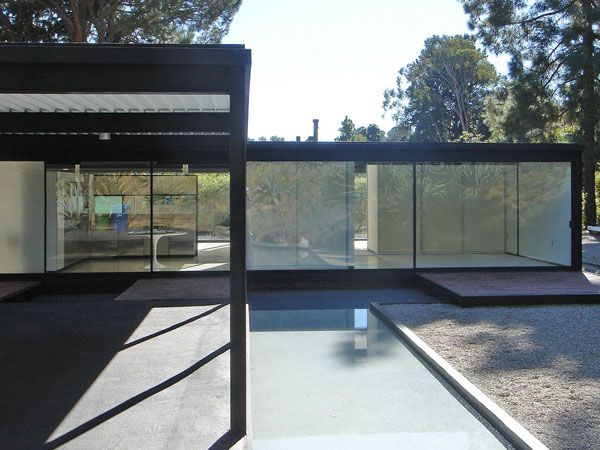 Ilpo's Sojourn, via Wikimedia Commons.
Ilpo's Sojourn, via Wikimedia Commons.Case Study House 21 (Pierre Koenig, architect), 1958
Neutra’s early work in California influenced the postwar generation of Angeleno architects such as Raphael Soriano (who was Neutra’s apprentice), Pierre Koenig (who was Soriano’s apprentice), Craig Ellwood (a self-taught designer of great talent), and Charles Eames (a designer, who had worked under Eliel Saarinen at the Cranbrook Academy of Art). Although obviously influenced by Mies as well as Neutra, their steel-frame buildings, assembled from off-the-shelf building components such as ordinary steel tubes and open-web joists, corrugated metal sheets and fiberglass panels, had a distinctive character: pragmatic, extremely light, industrial-looking and—compared to Mies—distinctly unmonumental.
-
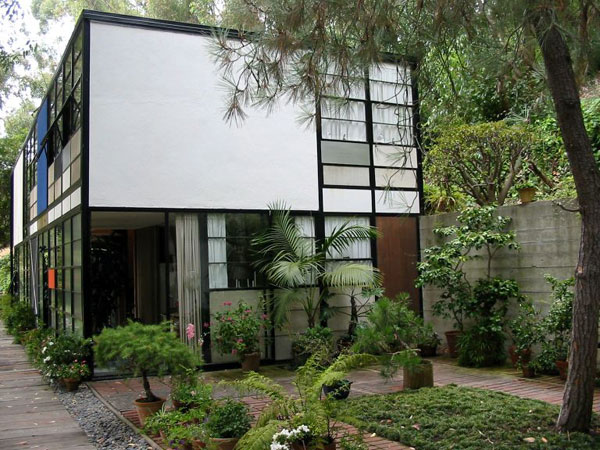 ercwttmn, via Wikimedia Commons.
ercwttmn, via Wikimedia Commons.Eames House (Charles and Ray Eames, architects), 1949
The steel-frame house and studio (left) that Charles and Ray Eames designed for themselves was probably the best-known example of Southern California modernism. According to writer and historian Reyner Banham, the Eames house “had a profound effect on many of the architects of my generation in Britain and Europe. It became the most frequently mentioned point of pilgrimage for intending visitors to Los Angeles among my friends.”
-
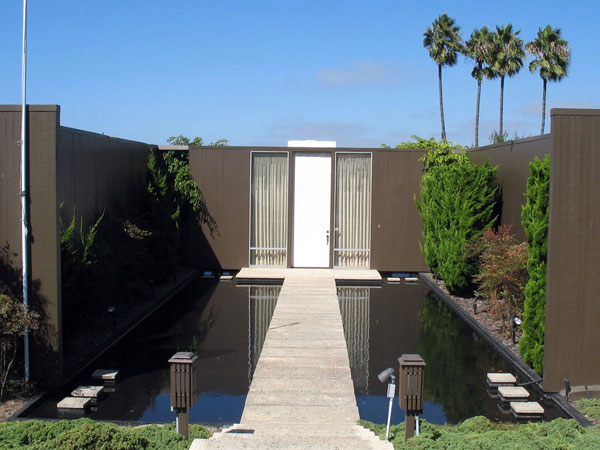 Allan Ferguson, via Wikimedia Commons.
Allan Ferguson, via Wikimedia Commons.Case Study House 23 (Killingsworth, Brady & Smith, architects), 1960
If lightweight modernism originated in Southern California, why did it re-emerge in Britain, rather than taking root in the United States? The second part of the question is easier to answer than the first. Neutra-inspired California modernism had a short run. Perhaps, as Banham has speculated, the rather ascetic style was at odds with the hedonistic culture of Los Angeles. By the mid-1960s, interest in minimalist houses had dried up, and Arts & Architecture magazine, published in Los Angeles, which had popularized the work of the Southern California architects and sponsored a series of experimental houses—the so-called Case Study Houses (left)—ceased publication. Soriano stopped building, Koenig moved into teaching, and Charles and Ray Eames focused on furniture, filmmaking, and exhibition design. Only Ellwood continued to build, but he seemed more like a survivor than the harbinger of something new
-
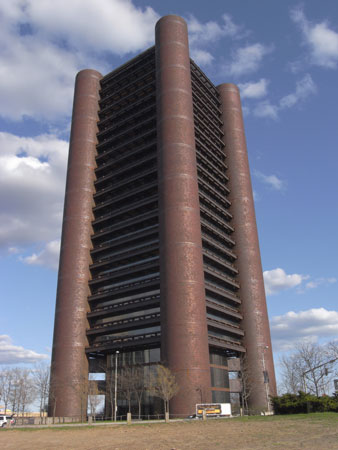 Seth Tisue, via Wikimedia Commons.
Seth Tisue, via Wikimedia Commons.Knights of Columbus Building, New Haven (Kevin Roche & John Dinkeloo, architects), 1969
Southern California modernism had only a slight national impact. Eero Saarinen, who collaborated with Eames on furniture, designed a lightweight, prefabricated house-building system for Arts & Architecture magazine in the 1940s, and incorporated skinny details into several industrial projects, eventually moved to a heavier, more expressive style. So did Skidmore, Owings & Merrill, which had produced some extremely light steel designs in the 1950s. Paul Rudolph, who had started his career with a series of delicate steel-frame houses in Sarasota, Fla., in the late 1940s and early 1950s, shifted to concrete and brutalism. East Coast architects such as Rudolph, Philip Johnson, I. M. Pei, Louis Kahn, Gordon Bunshaft of SOM, and Saarinen’s successor Kevin Roche, favored concrete, and produced buildings like Roche’s Knights of Columbus Building (left), monumental and definitely not lightweight. Like the others, Roche punched in the heavyweight division.
-
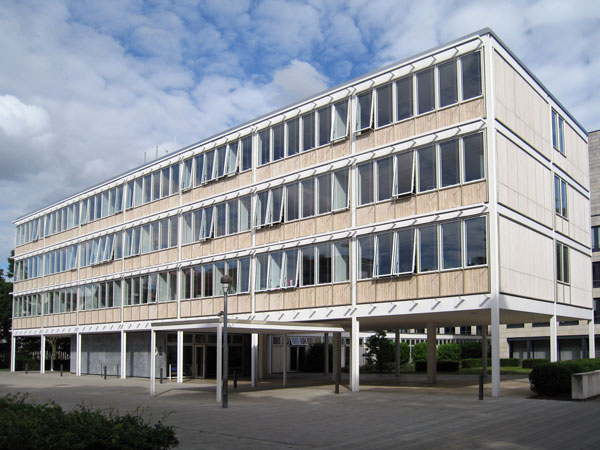 Till F. Teenck, via Wikimedia Commons.
Till F. Teenck, via Wikimedia Commons.American Consulate, Bremen (Skidmore, Owings & Merrill, architect), 1954
The answer to the question of why lightweight modernism surfaced in Britain in the 1970s is complicated. To the generation of British architects who came of age surrounded by the grim, heavy concrete style that dominated postwar British architecture, lightweight California modernism had a special appeal. “There was a romantic idea about American technology, which represented a clean break with the past,” says Birkin Haward, an architect who worked for Foster. “Norman was very keen on SOM, especially the early work.” Haward remembers a large photograph of a steel-and-glass façade—Skidmore, Owings & Merrill’s Gunner’s Mates School in Great Lakes, Ill.—hanging in the office. The firm’s no-nonsense American consulate in Bremen (left) is from the same period.
-
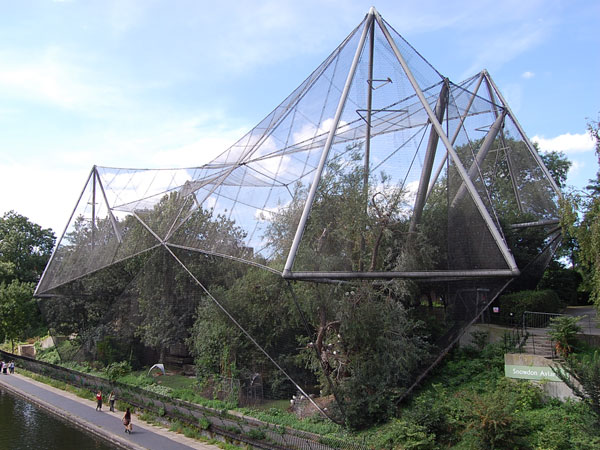 heena_mistry, via Wikimedia Commons.
heena_mistry, via Wikimedia Commons.Aviary, London Zoo (Lord Snowdon, Frank Newby, Cedric Price, architects), 1960-63
Foster was hardly alone in his admiration for lightweight American architecture. Reyner Banham, who was based in London but spent several years teaching in the United States, dedicated Los Angeles: The Architecture of Four Ecologies, still the best book on the modernist architecture of Southern California, to the British architect Cedric Price, whom he credited with directing his attention to the subject. Price built little, his aviary for the London Zoo (left) an exception, but his theoretical projects and writings on adaptable architecture were influential, and his Fun Palace project is said to have inspired the Pompidou Centre. Peter Cook and his colleagues in the group Archigram, who taught, lectured, and published widely in the 1960s, likewise advocated a lightweight architecture that incorporated flexibility and change.
-
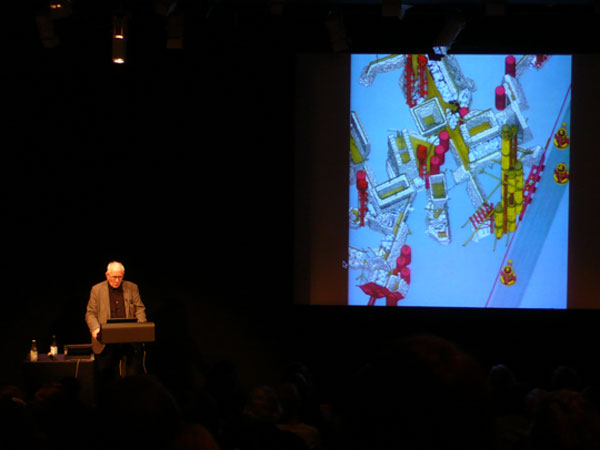 Plindberg, via Wikimedia Commons.
Plindberg, via Wikimedia Commons.Peter Cook lecturing on Plug-In City
Archigram’s visionary projects, such as Plug-In City and the Walking City, incorporated prefabricated capsules and robots, combining images from science fiction with American aerospace technology. The projects of Price and Archigram appeared in the pages of Architectural Design, which also published Foster’s work. All were a part of 1960s Swinging London—Carnaby Street, Twiggy, the Beatles—and the combination of brash futurism; irreverent gadgetry; and stylish, youthful glamour seemed like the perfect architectural analog for the age.
-
 Harry Wilson, via Wikimedia Commons.
Harry Wilson, via Wikimedia Commons.Kylesku Bridge, Scotland (Ove Arup & Partners, engineers), 1984
A key reason why the technological strain of modernism took root in Britain was the presence of a strong engineering tradition. Engineer Tony Hunt, who collaborated with Foster on many early projects, points to “the presence of a cadre of engineers who were interested in collaborating with architects.” Architects and engineers work together everywhere, of course, but in Britain it was the nature of the collaboration that mattered: intellectual, creative, and continuing from project to project. The British custom of close teamwork was influenced by the civil engineer Ove Arup. A prewar Danish immigrant, Arup founded what has turned out to be one of the best-known—and most enduring—engineering firms in the world (left). Arup’s stated ideal was “a relatively closely knit team, working in the same place and having a continuity of work on a few jobs at a time, so that the members could really learn to appreciate one another’s qualities, or if necessary shed those members who didn't fit.” Ove Arup & Partners was the engineering consultant of choice for architects such as Foster and Rogers, and worked on the Hongkong Bank, Stansted Airport, the Pompidou Centre, and Lloyd’s of London.
-
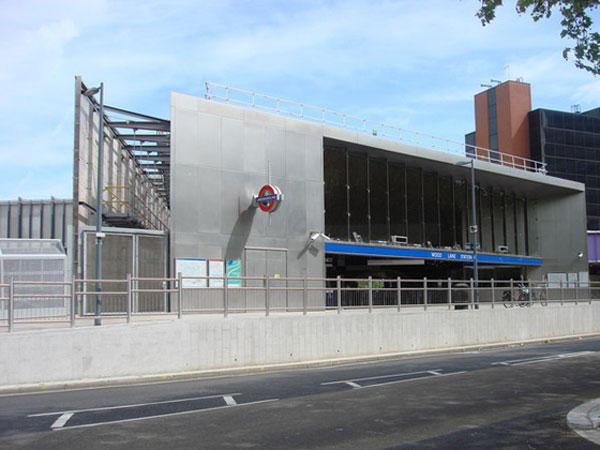 Oxyman, via Wikimedia Commons.
Oxyman, via Wikimedia Commons.Wood Lane Tube Station, London (Ian Ritchie, architect), 2008
In the 1970s, when British high-tech surfaced, the prevailing architectural style was postmodernism, one of whose seminal tracts was Robert Venturi’s Learning From Las Vegas. The second part of the book is titled “Ugly and Ordinary Architecture,” referring to everyday materials and construction methods. The iconic buildings of postmodernism, such as Venturi’s Vanna Venturi house, Charles Moore’s Sea Ranch, Philip Johnson’s AT&T Building, and Michael Graves’s Portland Building, were structurally and technologically conventional. British high-tech architects, on the other hand, philosophically committed to advancing the state of the building art, were willing, even eager, to innovate and experiment. Among the younger generation are Eva Jiricna, who apprenticed with Rogers, and Foster alumni Ian Ritchie (left), Richard Horden, and the late Jan Kaplický, founder of Future Systems.
-
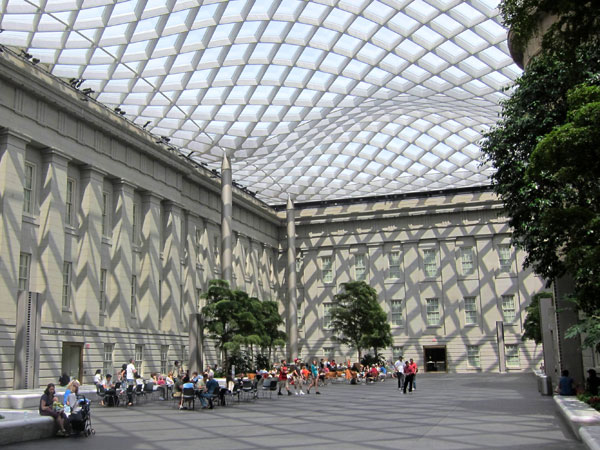 AgnosticPreachersKid, via Wikimedia Commons.
AgnosticPreachersKid, via Wikimedia Commons.Old Patent Office Building Courtyard, Washington, D.C. (Foster & Partners, architects, Buro Happold, engineers), 2007
The British high-tech architects saw themselves as part of a tradition. “I believe that architects have always used the very best technology and materials available at the time, and that’s what Norman was doing,” says Roy Fleetwood, who worked in the Foster office at the time of the Hong Kong Bank project. Foster’s team always pushed the boundaries of structural possibility, as in the billowy glass roof that effortlessly covers the courtyard of the Old Patent Office Building in Washington, D.C. (left). Referring to Michael Graves, who had recently beaten Foster in the Humana headquarters competition, Foster associate Richard Horden told an interviewer, “I think we [architects] are all like mountaineers. Michael Graves is the kind of eccentric chap who goes up all alone with a walking stick. We use crampons, pitons, and oxygen … and we go up higher.”
Excerpted from The Biography of a Building: How Robert Sainsbury and Norman Foster Built a Great Museum by Witold Rybczynski, published this month in London and New York by Thames & Hudson.
Excerpted from The Biography of a Building: How Robert Sainsbury and Norman Foster Built a Great Museum by Witold Rybczynski, published this month in London and New York by Thames & Hudson.